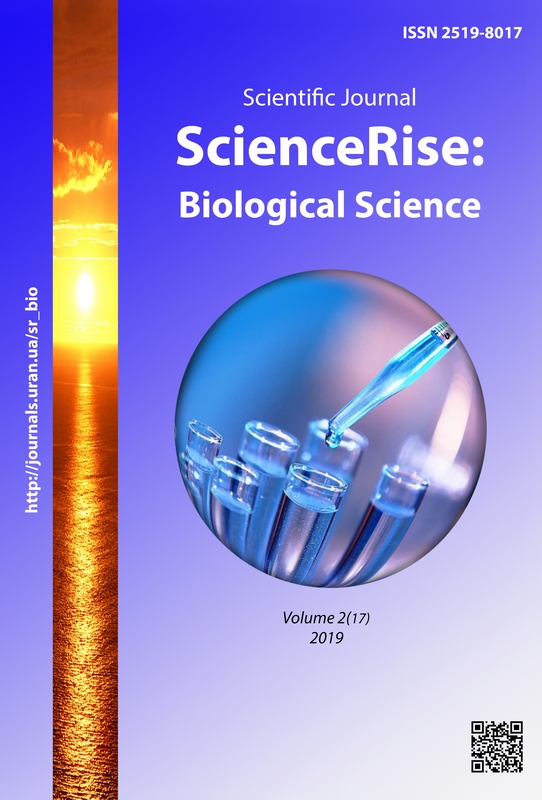Polymorphism of gene Hemagglutinin and its influence on the properties of influenza virus a H1N1 and H7N9 strains
DOI:
https://doi.org/10.15587/2519-8025.2019.168500Keywords:
polymorphism, hemagglutinin, Influenza A virus, H1N1, H7N9, cluster analysisAbstract
Influenza virus A is a causative agent of zoonotic and anthroponosis diseases. Virulence and contagious properties of the influenza virus are dependent on the presence of hemagglutinin. The membrane glycoprotein hemagglutinin has an important part in the adhesion and invasion of the influenza virus to the cell, as well as in the formation of immunity of the host organism. Hemagglutinin forms pandemic properties of influenza strains. Systematics and characterization of the influenza virus strains are based in particular on the type of hemagglutinin. The most contagious strains of the influenza A virus are strains H1N1 and H7N9. Polymorphism of hemagglutinin and its effect on the properties of influenza strains makes it relevant to study its variability.
The aim of the study. The purpose of the study was to determine the polymorphism of the hemagglutinin encoding gene of strains of the influenza A H1N1 and H7N9 strains, to determine its effect on the polymorphism of the amino acid sequences of hemagglutinin and the properties of the strains by bioinformatic research methods.
Materials and methods. The nucleotide sequences of hemagglutinin of influenza A H1N1 and H7N9 strains and products of its translation were analyzed by cluster analysis. The properties of hemagglutinin were defined by determining its domains.
Results and discussion. As a result of the study, the polymorphism and genetic distances between the alleles of the gene encoding hemagglutinin of the influenza virus have been calculated and its translation has been carried out. The polymorphism and amino acid distances between the products of its translation were detected; a comparative analysis between the nucleotide and amino acid sequences was performed. The influence and effect of synonymouscodons in the nucleotide sequences of the alleles of the hemagglutinin encoding gene on the hemagglutinin polymorphism was shown. The domains of the test samples of hemagglutinin were identified.
Conclusions. As a result of studies, the absence of the influence of the polymorphism of the hemagglutinin encoding gene on the hemagglutinin polymorphism was shown. The absence of the effect of polymorphism on the amino acid sequences of hemagglutinin of influenza A H1N1 and H7N9 strains, as well as on the domain composition and, thus, on the properties of strains was determinedReferences
- Gamblin, S. J., Skehel, J. J. (2010). Influenza Hemagglutinin and Neuraminidase Membrane Glycoproteins. Journal of Biological Chemistry, 285 (37), 28403–28409. doi: http://doi.org/10.1074/jbc.r110.129809
- Efron, B. (1979). Bootstrap Methods: Another Look at the Jackknife. The Annals of Statistics, 7 (1), 1–26. doi: http://doi.org/10.1214/aos/1176344552
- Sauer, A.-K., Liang, C.-H., Stech, J., Peeters, B., Quéré, P., Schwegmann-Wessels, C. et. al. (2014). Characterization of the Sialic Acid Binding Activity of Influenza A Viruses Using Soluble Variants of the H7 and H9 Hemagglutinins. PLoS ONE, 9 (2), e89529. doi: http://doi.org/10.1371/journal.pone.0089529
- Smith, T. F., Waterman, M. S. (1981). Identification of common molecular subsequences. Journal of Molecular Biology, 147 (1), 195–197. doi: http://doi.org/10.1016/0022-2836(81)90087-5
- Brockwell-Staats, C., Webster, R. G., Webby, R. J. (2009). Diversity of influenza viruses in swine and the emergence of a novel human pandemic influenza A (H1N1). Influenza and Other Respiratory Viruses, 3 (5), 207–213. doi: http://doi.org/10.1111/j.1750-2659.2009.00096.x
- Tamura, K., Peterson, D., Peterson, N., Stecher, G., Nei, M., Kumar, S. (2011). MEGA5: Molecular Evolutionary Genetics Analysis Using Maximum Likelihood, Evolutionary Distance, and Maximum Parsimony Methods. Molecular Biology and Evolution, 28 (10), 2731–2739. doi: http://doi.org/10.1093/molbev/msr121
- Taubenberger, J. K., Kash, J. C. (2010). Influenza Virus Evolution, Host Adaptation, and Pandemic Formation. Cell Host & Microbe, 7 (6), 440–451. doi: http://doi.org/10.1016/j.chom.2010.05.009
- Webster, R. G., Bean, W. J., Gorman, O. T., Chambers, T. M., Kawaoka, Y. (1992). Evolution and ecology of influenza A viruses. Microbiological Reviews, 56 (1), 152–179.
- Wilks, S., de Graaf, M., Smith, D. J., Burke, D. F. (2012). A review of influenza haemagglutinin receptor binding as it relates to pandemic properties. Vaccine, 30 (29), 4369–4376. doi: http://doi.org/10.1016/j.vaccine.2012.02.076
- Kumar, S., Tamura, K., Nei, M. (2004). MEGA3: Integrated software for Molecular Evolutionary Genetics Analysis and sequence alignment. Briefings in Bioinformatics, 5 (2), 150–163. doi: http://doi.org/10.1093/bib/5.2.150
Downloads
Published
How to Cite
Issue
Section
License
Copyright (c) 2019 Semen Buriachenko, Borys Stegniy

This work is licensed under a Creative Commons Attribution 4.0 International License.
Our journal abides by the Creative Commons CC BY copyright rights and permissions for open access journals.
Authors, who are published in this journal, agree to the following conditions:
1. The authors reserve the right to authorship of the work and pass the first publication right of this work to the journal under the terms of a Creative Commons CC BY, which allows others to freely distribute the published research with the obligatory reference to the authors of the original work and the first publication of the work in this journal.
2. The authors have the right to conclude separate supplement agreements that relate to non-exclusive work distribution in the form in which it has been published by the journal (for example, to upload the work to the online storage of the journal or publish it as part of a monograph), provided that the reference to the first publication of the work in this journal is included.









